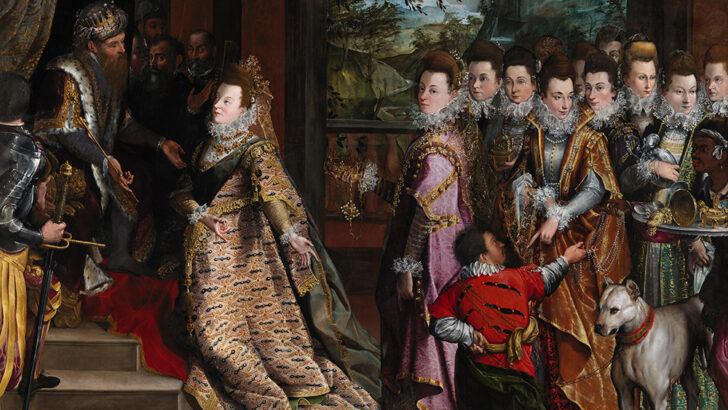Lavinia Fontana: Trailblazer, Rule Breaker,
by Aoife Brady, with essays by Babette Bohn and Jonquil O’Reilly
(National Gallery of Ireland, distributed by Yale University Press, €40.00 / £35.00)
Exhibition: May 6-August 27; Rooms 6-10, Beit Wing | Ticketed, check opening hours online.
Lavinia Fontana (1552 – 1614) was a remarkable artist of great achievement, but perhaps her greatest achievement was to have become an artist at all in an age dominated by men. But become an artist she did, and the Summer Exhibition at the National Gallery is devoted to an overview of her work, with pieces culled from the gallery’s own collection, with others brought from abroad.
The most magnificent piece, The Visit of the Queen of Sheba to King Solomon (1599) has been in the collection since the early days, but recently with the aid of a grant from the show’s sponsor Bank of America, has been meticulously restored and become almost a new, truly stunning painting.
Lavinia was, however, the daughter of a painter, and it was under him that she began to develop her talents. At first her commissions were dominated by men, for religious pictures and portraits of grandees. but in time her main clientele became the women of the nobility of the city, the so-called “Forty Families”.
Her fame and talent were rewarded, but she also managed to give her painting a very human sense. In this show two smallish pictures stand out, one of an adolescent boy (late 1590s), and another of a widow (c. 1595), where she shows a woman still racked by grief, her eyes red with tears.

The ladies she painted were, naturally enough, interested in having for domestic placement pictures of their children, and these are very remarkable too.
However, in time as she became more established, she was able to move onto paintings dealing with allegory and myth, a more difficult area, as the city was then under direct papal rule and the archbishop was strict about what could be painted for public view.
But as many of her paintings went into private domestic collections, this concerned her less. Certainly Mars and Venus (c. 1595) any time, even today, might be a picture difficult to hang in some places. She was the first woman artist to paint the nude human figure, here again breaking ground for future artists of her sex.
The last room of the exhibition, after all these striking pictures, is reserved for the full glory of the restored image of Solomon and Sheba, the south Arabian ruler being followed by a train of her court ladies (one suspects an opportunity for many of the young beauties of the city to have themselves painted).
Lavinia’s range was very great from the delicately intimate and understands the opulence of the Renaissance ideal of regal and court life. These various aspects are explored by Aoife Brady, who brought all this together with the support of the new director Dr Caroline Campbell. The book also explores with Babette Bohn and Jonquil O’Reilly aspects of the material culture of the city especially in fabrics and fashion, in which they have an important part. What they write will mean a couple of return visits for many.
However, the dates will have alerted the viewer to the fact that this was an important era for European culture, the era of Shakespeare, of Cervantes, the Counter Reformation, and of the wealth that was flowing into Europe from the Americas. But for Bologna it was the eve of a long decline, the students moved elsewhere, disease reduced the active population, and the city, according to some, only recovered in recent times. Art, we are reminded, has both its glories and its vicissitudes.


 Peter Costello
Peter Costello Visit of the Queen of Sheba to King Solomon, courtesy of the National Gallery of Ireland.
Visit of the Queen of Sheba to King Solomon, courtesy of the National Gallery of Ireland. 